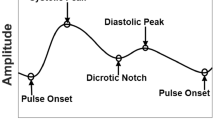Abstract
This study presents a high-precision real-time detection system to detect arrhythmia of premature ventricular contraction (PVC). This system detects the peak of the R-wave based on wavelet transform (WT) and then uses a new algorithm to detect PVC. The proposed PVC detection algorithm combines the sum of trough and sum of R_peak with minimum to detect PVC. A crucial function of morbid warning is implemented in this system so that users receive an alert signal when PVC is detected. The proposed system is simulated and verified using the MIT-BIH Arrhythmia Database (mitdb). The system is also implemented by FPGA to illustrate its high precision and real-time performance.










Similar content being viewed by others
References
Alptekin, O., & Akan, A. (2010). Detection of some heart diseases by the analysis of ECG signals. In Signal Processing and Communications Applications Conference (SIU) (pp. 716–719). Diyarbakir, 22–24 April. doi:10.1109/SIU.2010.5654437.
Yuan, J., Tan, K. K., & Lee, T. H. (2010). Development of an e-Guardian for the single elderly or chronically-Ill patients. In International Conference on Communications and Mobile Computing (CMC), vol. 3 (pp. 378–382). Shenzhen, 12–14 April. doi:10.1109/CMC.2010.167.
Marzencki, M., Hung, B., Lin, P., Huang, Y., Cho, T., Chuo, Y., & Kaminska, B. (2010). Context-aware physiological data acquisition and processing with wireless sensor networks. In IEEE International Workshop on Medical Measurements and Applications (MeMeA), (pp. 53–56). Ottawa, ON, 30 April-1 May. doi:10.1109/MEMEA.2010.5480203.
Park, C., Chou, P. H., Bai, Y., Matthews, R., & Hibbs, A. (2006). An ultra-wearable, wireless, low power ECG monitoring system. In IEEE Biomedical Circuits and Systems Conference (BioCAS) (pp. 241–244). London, 29 Nov.–1 Dec. doi:10.1109/BIOCAS.2006.4600353.
Yang, Y., Huang, X., & Yu, X. (2007). Real-time ECG monitoring system based on FPGA. In Annual Conference of the IEEE Industrial Electronics Society (IECON) (pp. 2136–2140). Taipei, 5–8 Nov. doi:10.1109/IECON.2007.4459886.
Paul, J. S., Reddy, M. R. S., & Kumar, V. J. (1997). Automatic detection of PVC’s using autoregressive models. In Annual International Conference of IEEE Engineering in Medicine and Biology Society (EMBS), vol. 1 (pp. 68–71). Chicago, IL, 30 Oct.–2 Nov. doi:10.1109/IEMBS.1997.754465.
Zhao, L., Wiggins, M., & Vachtsevanos, G. (2003). Premature ventricular contraction beat detection based on symbolic dynamics analysis. In International Conference on Circuits, Signals and Systems (CSS) (pp. 48–50). Cancun, Mexico, 19–21 May. doi: From Proceeding (391) Circuits, Signals, and Systems - 2003.
Chiu, C. C., Lin, T. H., & Liau, B. Y. (2005). Using correlation coefficient in ECG waveform for arrhythmia detection. Biomedical Engineering: Applications, Basis and Communications, 17(3), 147–152.
Nahar, S., & ShahNoor bin Munir, M. (2009). Automatic detecion of premature ventricular contraction beat using morphological transformation and cross-correlation. In International Conference on Signal Processing and Communication Systems (ICSPCS) (pp. 1–4). Omaha, NE, 28–30 Sept. doi:10.1109/ICSPCS.2009.5306426.
Shen, Z., Hu, C., Liao, J., & Meng, M. Q.-H. (2010). An algorithm of premature contraction detection based on wavelet method. In International Conference on Information and Automation (ICIA) (pp. 1053–1058). Harbin, 20–23 June. doi:10.1109/ICINFA.2010.5512157.
Qiu, Y., Ding, X., Feng, J., & Mo, Z. (2006). QRS complexes detection based on Mexican-hat wavelet. Journal of Biomedical Engineering, 23(6), 1347–1349.
Fejtová, M., Macek, J., & Lhotská, L. (2001). ECG events detection and classification using wavelet transform and decision trees. In Final Programme & Proceedings EUNITE (pp. 496–499).
Inan, O. T., Giovangrandi, L., & Kovacs, G. T. A. (2006). Robust neural-network based classification of premature ventricular contractions using wavelet transform and timing interval features. IEEE Transactions on Biomedical Engineering, 53(12), 2507–2515.
Lim, J. S. (2009). Finding features for real-time premature ventricular contraction detection using a fuzzy neural network system. IEEE Transactions on Neural Networks, 20(3), 522–527.
Andreao, R. V., Dorizzi, B., & Boudy, J. (2006). ECG signal analysis through hidden Markov models. IEEE Transactions on Biomedical Engineering, 53(8), 1541–1549.
Gomes, P. R., Soares, F. O., Correia, J. H., & Lima, C. S. (2009). Cardiac arrhythmia classification using wavelets and hidden Markov models-A comparative approach. In Annual International Conference of IEEE Engineering in Medicine and Biology Society (EMBS) (pp. 4727–4730). Minneapolis, Minnesota, USA, 2–6 Sep. doi:10.1109/IEMBS.2009.5334192.
Moody, G. B., & Mark, R. G. (2001). The impact of the MIT-BIH arrhythmia database. IEEE Engineering in Medicine and Biology Magazine, 20(3), 45–50.
Goldberger, A. L., Amaral, L. A. N., & Glass, L. (2000). PhysioBank, PhysioToolkit, and PhysioNet: components of a new research resource for complex physiologic signals. Circulation, 101(23), 215–220.
Mark, R. G., Schluter, P. S., Moody, G. B., Devlin, P. H., & Chernoff, D. (1982). An annotated ECG database for evaluating arrhythmia detectors. In Annual International Conference of IEEE Engineering in Medicine and Biology Society (EMBS) (pp. 205–210).
Zheng, X., Li, Z., Shen, L., & Ji, Z. (2008). Detection of QRS complexes based on biorthogonal spline wavelet. In International Symposium on Information Science and Engineering (ISISE) (pp. 502–506). Shanghai, 20–22 Dec., 2. doi:10.1109/ISISE.2008.61.
Mallat, S. (1992). Characterization of signals from multiscale edges. IEEE Transactions on Pattern Analysis and Machine Intelligence, 14(7), 710–732.
Wang, C., & Lu, Y. (2011). Using biorthogonal wavelet filter band for ECG detection and reconstruction. Beijing Biomedical Engineering, 20(1), 25–29.
Pachauri, A., & Bhuyan, M. (2009). Wavelet and energy based approach for PVC detection. In International Conference on Emergin Trends in Electronic and Photonic Devices & Systems (pp. 258–261) Varanasi, 22–24 Dec. doi:10.1109/ELECTRO.2009.5441123.
Acknowledgments
This work was supported in part by the National Science Council (NSC), Taiwan, R.O.C. under Grant NSC 102-2220-E-005-001 and in part by the Ministry of Education, Taiwan, under the Aim for the Top University Plan. The authors would like to thank the National Chip Implementation Center of Taiwan for the technical support.
Author information
Authors and Affiliations
Corresponding author
Rights and permissions
About this article
Cite this article
Chang, R.CH., Lin, CH., Wei, MF. et al. High-Precision Real-Time Premature Ventricular Contraction (PVC) Detection System Based on Wavelet Transform. J Sign Process Syst 77, 289–296 (2014). https://doi.org/10.1007/s11265-013-0823-6
Received:
Revised:
Accepted:
Published:
Issue Date:
DOI: https://doi.org/10.1007/s11265-013-0823-6




